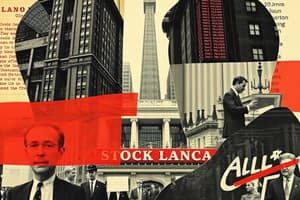Podcast
Questions and Answers
What is a potential consequence of a regulatory ban on short selling for certain stocks?
What is a potential consequence of a regulatory ban on short selling for certain stocks?
- It may create an upward spike in prices as sellers cover positions. (correct)
- It allows short sellers to extend their positions indefinitely.
- It has no effect on the market prices of those stocks.
- It ensures all short sellers will profit.
How might the SEC's actions during the credit crisis impact investor behavior?
How might the SEC's actions during the credit crisis impact investor behavior?
- Investors may become more cautious in their trading strategies due to increased volatility. (correct)
- Investors would likely increase their short selling activities.
- Investors could ignore regulatory changes and continue as usual.
- Investors would focus exclusively on buying stocks.
What is one main difference between trading long on margin and selling short?
What is one main difference between trading long on margin and selling short?
- Buying long on margin involves borrowing funds to purchase stocks, while selling short involves borrowing stocks. (correct)
- Selling short is typically less risky than buying long on margin.
- Selling short allows for guaranteed profits, unlike buying long on margin.
- Buying long on margin is only applicable for large investors.
Why might investment dealers act as agents in a securities transaction?
Why might investment dealers act as agents in a securities transaction?
During times of regulatory intervention, what typically happens to short sellers?
During times of regulatory intervention, what typically happens to short sellers?
What characterizes the roles of investment dealers in a traditional trade involving two customers?
What characterizes the roles of investment dealers in a traditional trade involving two customers?
What is the primary advantage of using a limit order?
What is the primary advantage of using a limit order?
What happens to a limit order if the specified price is never reached during the trading day?
What happens to a limit order if the specified price is never reached during the trading day?
In a market order for selling shares, which price does the seller receive?
In a market order for selling shares, which price does the seller receive?
Which statement best describes a day order?
Which statement best describes a day order?
What is a potential downside of using a limit order?
What is a potential downside of using a limit order?
If a buyer places a limit order to buy shares at $20 or less, which scenario would cause the order to execute?
If a buyer places a limit order to buy shares at $20 or less, which scenario would cause the order to execute?
What is the bid price in a market order context?
What is the bid price in a market order context?
If a limit sell order is placed at $20 or more, what is true about its execution?
If a limit sell order is placed at $20 or more, what is true about its execution?
What is the present value of the principal when investing $67.68 at a semi-annual rate of 5% for four years?
What is the present value of the principal when investing $67.68 at a semi-annual rate of 5% for four years?
What is the sum of the present values of both the coupons and the principal of the bond?
What is the sum of the present values of both the coupons and the principal of the bond?
If the appropriate discount rate for a bond changes due to economic conditions, what does this affect?
If the appropriate discount rate for a bond changes due to economic conditions, what does this affect?
What is the calculated present value of the bond when using the financial calculator with a discount rate of 10%?
What is the calculated present value of the bond when using the financial calculator with a discount rate of 10%?
What does a bond's fair value indicate about its potential price in the secondary market?
What does a bond's fair value indicate about its potential price in the secondary market?
What is the significance of knowing how to perform present value calculations manually?
What is the significance of knowing how to perform present value calculations manually?
What is the primary risk faced by short sellers when the price of the security increases?
What is the primary risk faced by short sellers when the price of the security increases?
Which order type is defined as an instruction to buy or sell at a specified price or better?
Which order type is defined as an instruction to buy or sell at a specified price or better?
What happens to a day order if it is not executed on the day it is entered?
What happens to a day order if it is not executed on the day it is entered?
Which order type specifies a cancellation date provided by the client?
Which order type specifies a cancellation date provided by the client?
What is the purpose of an on-stop sell order?
What is the purpose of an on-stop sell order?
Which type of order is specifically designed for accounts of investment advisors and directors?
Which type of order is specifically designed for accounts of investment advisors and directors?
What must a buyer do once they receive confirmation of a trade?
What must a buyer do once they receive confirmation of a trade?
What is the typical consequence if the price of a security rises unexpectedly for a short seller?
What is the typical consequence if the price of a security rises unexpectedly for a short seller?
Which statement correctly describes the settlement date process?
Which statement correctly describes the settlement date process?
Which type of order would not execute until the security reaches a specified price?
Which type of order would not execute until the security reaches a specified price?
Flashcards are hidden until you start studying
Study Notes
Regulatory Risk
- Regulatory risk involves the potential for regulators to prohibit short selling for certain stocks, notably observed during the credit crisis.
- The SEC's ban on short sales for banks and financial institutions forced short sellers to cover positions, leading to price spikes and losses.
Trading on Margin
- Buying long on margin differs from selling short; understanding margin strategies is crucial for investment decisions.
- Equity transactions require knowledge of trading and settlement procedures, often involving investment dealers acting as agents.
Orders in Trading
- Market Order: Executed immediately at the current market price (example: buy 1,000 shares of ABC at $20.10).
- Limit Order: Buy or sell at a specified price or better (example: buy ABC at $20 or less; may not execute if not reached).
- Day Order: Expires at the end of the day if not executed.
Settlement Procedures
- Settlement involves the exchange's data transmission system reporting trade details with confirmations sent to buyers and sellers.
- Buyers provide payment, while sellers deliver the security, with timelines varying based on the type of securities.
Types of Orders
- Good Til Order: Remains in effect until the date specified by the client or market.
- On-stop Orders: Triggered when the security reaches a specified price (sell if it drops below a certain point, buy if it rises).
- PRO Order: Reserved for accounts of partners, officers, or specified employees.
Present Value of Bonds
- Fair price of a bond includes present value of coupons and principal at an appropriate discount rate.
- Present value calculations consider different economic conditions and reflect expected yields.
Current Yield Calculation
- Current yield formula: Current Yield = (Annual Cash Flow / Current Market Price) x 100.
- Example: For a bond with a 9% annual cash flow priced at 96.77, the current yield is approximately 9.30%.
Yield to Maturity (YTM)
- YTM calculates total expected return on a bond, assuming reinvestment of coupon payments at the same YTM.
- Takes into account current market price, term to maturity, par value received at maturity, and coupon rate.
- YTM reflects investor's returns as coupon income and any capital gains or losses realized over time.
Buying Bonds at a Premium
- Investors may buy bonds at a premium, despite potential capital loss at maturity; bond valuation considers more than just purchase price.
Studying That Suits You
Use AI to generate personalized quizzes and flashcards to suit your learning preferences.




